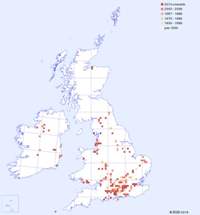The Green-flowered Helleborine shows such variability that it has been divided into four described varieties (var. pendula, var. vectensis, var. phyllanthes and var. degenera) - although just three might be more appropriate and would certainly be less confusing. They are briefly described below. Although preferring alkaline soils, this species grows in a range of habitats but is mostly found in or on the edges of lightly shaded woodland. Epipactis phyllanthes also occurs on roadside verges that flank woodland and where there is ivy ground cover. This species is confined to the southern half of the England and Wales and a few scattered locations in Northern Ireland. Green-flowered Helleborine flowers between late June and September. In mainland Europe this orchid is found in Denmark in the north and probably as far south as Spain, although confusion with other species may make some reports suspect. Epipactis phyllanthes is classified as Nationally Scarce in Britain, and it is also protected in Northern Ireland.
| Distribution Map | Key Features | |
 |
Records for the Green-flowered Helleborine from BSBI are shown on the map with most recent in front. (Hover the mouse over the small map to expand it.) |
Plant (typical specimen): 7 to 50cm tall, occasionally to 75cm. The stem, which is thick and flushed purple towards the base, sometimes has sparse short hairs. |
Image Gallery for Green-flowered Helleborine Epipactis phyllanthes
| Pollination | Taxonomy & Hybrids |
Epipactis phyllanthes is self-pollinated, sometimes within the bud. |
The specific name phyllanthes may refer to Phillis Woods, where the plants were first collected, or to Greek words meaning 'leaf-like flower'. Subspecies: none. |
Articles about Green-flowered Helleborine in JHOS
